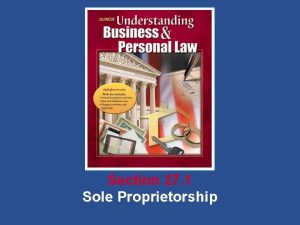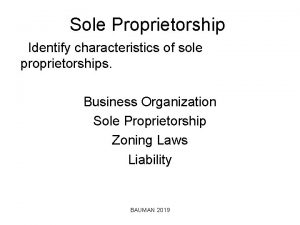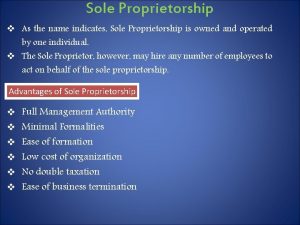A sole proprietorship is the simplest and most















- Slides: 15

A sole proprietorship is the simplest and most common structure chosen to start a business. It is an unincorporated business owned and run by one individual with no distinction between the business and you, the owner. You are entitled to all profits and are responsible for all your business’s debts, losses and liabilities. Forming a Sole Proprietorship You do not have to take any formal action to form a sole proprietorship. As long as you are the only owner, this status automatically comes from your business activities. In fact, you may already own one without knowing it. If you are a freelance writer, for example, you are a sole proprietor. But like all businesses, you need to obtain the necessary licenses and permits. Regulations vary by industry, state and locality. Use the Licensing & Permits Tool to find a listing of federal, state and local permits, licenses and registrations you'll need to run a business. If you choose to operate under a name different than your own, you will most likely have to file a fictitious name (also known as an assumed name, trade name, or DBA name, short for "doing business as"). You must choose an original name; it cannot already be claimed by another business. Advantages of a Sole Proprietorship • • • Easy and inexpensive to form: A sole proprietorship is the simplest and least expensive business structure to establish. Costs are minimal, with legal costs limited to obtaining the necessary license or permits. Complete control. Because you are the sole owner of the business, you have complete control over all decisions. You aren’t required to consult with anyone else when you need to make decisions or want to make changes. Easy tax preparation. Your business is not taxed separately, so it’s easy to fulfill the tax reporting requirements for a sole proprietorship. The tax rates are also the lowest of the business structures.

Disadvantages of a Proprietorship • • • Unlimited personal liability. Because there is no legal separation between you and your business, you can be held personally liable for the debts and obligations of the business. This risk extends to any liabilities incurred as a result of employee actions. Hard to raise money. Sole proprietors often face challenges when trying to raise money. Because you can’t sell stock in the business, investors won't often invest. Banks are also hesitant to lend to a sole proprietorship because of a perceived lack of credibility when it comes to repayment if the business fails. Heavy burden. The flipside of complete control is the burden and pressure it can impose. You alone are ultimately responsible for the successes and failures of your business.

Limited Liability Company A limited liability company is a hybrid type of legal structure that provides the limited liability features of a corporation and the tax efficiencies and operational flexibility of a partnership. The "owners" of an LLC are referred to as "members. " Depending on the state, the members can consist of a single individual (one owner), two or more individuals, corporations or other LLCs. Unlike shareholders in a corporation, LLCs are not taxed as a separate business entity. Instead, all profits and losses are "passed through" the business to each member of the LLC members report profits and losses on their personal federal tax returns, just like the owners of a partnership would. Forming an LLC Choose a Business Name. There are 3 rules that your LLC name needs to follow: (1) it must be different from an existing LLC in your state, (2) it must indicate that it's an LLC (such as "LLC" or Limited Company") and (3) it must not include words restricted by your state (such as "bank" and "insurance"). Your business name is automatically registered with your state when you register your business, so you do not have to go through a separate process. Read more here about choosing a business name. File the Articles of Organization. The "articles of organization" is a simple document that legitimizes your LLC and includes information like your business name, address, and the names of its members. For most states, you file with the Secretary of State. However, other states may require that you file with a different office such as the State Corporation Commission, Department of Commerce and Consumer Affairs, Department of Consumer and Regulatory Affairs, or the Division of Corporations & Commercial Code. Note: there may be an associated filing fee. Create an Operating Agreement. Most states do not require operating agreement. However, an operating agreement is highly recommended for multi-member LLCs because it structures your LLC's finances and organization, and provides rules and regulations for smooth operation. The operating agreement usually includes percentage of interests, allocation of profits and losses, member's rights and responsibilities and other provisions.

Obtain Licenses and Permits. Once your business is registered, you must obtain business licenses and permits. Regulations vary by industry, state and locality. Use the Licensing & Permits tool to find a listing of federal, state and local permits, licenses and registrations you'll need to run a business. Hiring Employees. If you are hiring employees, read more about federal and state regulations for employers. Announce Your Business. Some states, including Arizona and New York, require the extra step of publishing a statement in your local newspaper about your LLC formation. Check with your state's business filing office for requirements in your area. LLC Taxes In the eyes of the federal government, an LLC is not a separate tax entity, so the business itself is not taxed. Instead, all federal income taxes are passed on to the LLC's members and are paid through their personal income tax. While the federal government does not tax income on an LLC, some states do, so check with your state's income tax agency. Since the federal government does not recognize LLC as a business entity for taxation purposes, all LLCs must file as a corporation, partnership, or sole proprietorship tax return. Certain LLCs are automatically classified and taxed as a corporation by federal tax law. For guidelines about how to classify an LLC, visit IRS. gov. LLCs that are not automatically classified as a corporation can choose their business entity classification. To elect a classification, an LLC must file Form 8832. This form is also used if an LLC wishes to change its classification status. Read more about filing as a corporation or partnership and filing as a single member LLC at IRS. gov. Advantages of an LLC Limited Liability. Members are protected from personal liability for business decisions or actions of the LLC. This means that if the LLC incurs debt or is sued, members' personal assets are usually exempt. This is similar to the liability protections afforded to shareholders of a corporation. Keep in mind that limited liability means "limited" liability - members are not necessarily shielded from wrongful acts, including those of their employees.

Less Recordkeeping. An LLC's operational ease is one of its greatest advantages. Compared to an S-Corporation, there is less registration paperwork and there are smaller start-up costs. Sharing of Profits. There are fewer restrictions on profit sharing within an LLC, as members distribute profits as they see fit. Members might contribute different proportions of capital and sweat equity. Consequently, it's up to the members themselves to decide who has earned what percentage of the profits or losses. Disadvantages of an LLC Limited Life. In many states, when a member leaves an LLC, the business is dissolved and the members must fulfill all remaining legal and business obligations to close the business. The remaining members can decide if they want to start a new LLC or part ways. However, you can include provisions in your operating agreement to prolong the life of the LLC if a member decides to leave the business. Self-Employment Taxes. Members of an LLC are considered self-employed and must pay the self-employment tax contributions towards Medicare and Social Security. The entire net income of the LLC is subject to this tax.

Cooperative A cooperative is a business or organization owned by and operated for the benefit of those using its services. Profits and earnings generated by the cooperative are distributed among the members, also known as user-owners. Typically, an elected board of directors and officers run the cooperative while regular members have voting power to control the direction of the cooperative. Members can become part of the cooperative by purchasing shares, though the amount of shares they hold does not affect the weight of their vote. Cooperatives are common in the healthcare, retail, agriculture, art and restaurant industries. Forming a Cooperative Forming a cooperative is different from forming any other business entity. To start up, a group of potential members must agree on a common need and a strategy on how to meet that need. An organizing committee then conducts exploratory meetings, surveys, and cost and feasibility analyses before every member agrees with the business plan. Not all cooperatives are incorporated, though many choose to do so. If you decide to incorporate your cooperative, you must complete the following steps: • File Articles of Incorporation. The articles of incorporation legitimizes your cooperative and includes information like the name of the cooperative, business location, purpose, duration of existence, and names of the incorporators, and capital structure. Once the charter members (also known as the incorporators) file with your state business entity registration office and the articles are approved, you should create bylaws for your cooperative. • Create Bylaws. While the law does not require bylaws, they do need to comply with state law and are essential to the success of your cooperative. Bylaws list membership requirements, duties, responsibilities and other operational procedures that allow your cooperative to run smoothly. According to most state laws, the majority of your members must adopt articles of incorporation and bylaws. Consult an attorney to verify that your bylaws comply with state laws. • Create a Membership Application. To recruit members and legally verify that they are part of the cooperative, you must create and issue a membership application. Membership applications include names, signatures from the board of directors and member rights and benefits.

Conduct a Charter Member Meeting and Elect Directors. During this meeting, charter members discuss and amend the proposed bylaws. By the end of the meeting, all of the charter members should vote to adopt the bylaws. If the board of directors were not named in the articles of incorporation, you must designate them during the charter meeting. • Obtain Licenses and Permits. You must obtain relevant business licenses and permits. Regulations vary by industry, state and locality. Use our Licensing & Permits tool to find a list of federal, state and local permits, licenses and registrations you'll need to run a business. • Hiring Employees. If you are hiring employees, read more about federal and state regulations for employers. Each state will have slightly different laws that govern a cooperative. Consult an attorney, your Secretary of State or State Corporation Commissioner for more information regarding your state's specific laws. • Advantages of a Cooperative • • • Less Taxation. Similar to an LLC, cooperatives that are incorporated normally are not taxed on surplus earnings (or patronage dividends) refunded to members. Therefore, members of a cooperative are only taxed once on their income from the cooperative and not on both the individual and the cooperative level. Funding Opportunities. Depending on the type of cooperative you own or participate in, there a variety of governmentsponsored grant programs to help you start. For example, the USDA Rural Development program offers grants to those establishing and operating new and existing rural development cooperatives. Reduce Costs and Improve Products and Services. By leveraging their size, cooperatives can more easily obtain discounts on supplies and other materials and services. Suppliers are more likely to give better products and services because they are working with a customer of more substantial size. Consequently, the members of the cooperative can focus on improving products and services. Perpetual Existence. A cooperative structure brings less disruption and more continuity to the business. Unlike other business structures, members in a cooperative can routinely join or leave the business without causing dissolution. Democratic Organization. Democracy is a defining element of cooperatives. The democratic structure of a cooperative ensures that it serves its members' needs. The amount of a member's monetary investment in the cooperative does not affect the weight of each vote, so no member-owner can dominate the decision-making process. The "one member-one vote" philosophy particularly appeals to smaller investors because they have as much say in the organization as does a larger investor.

Disadvantages of a Cooperative • • Obtaining Capital through Investors. Cooperatives may suffer from slower cash flow since a member's incentive to contribute depends on how much they use the cooperative's services and products. While the "one member-one vote" philosophy is appealing to small investors, larger investors may choose to invest their money elsewhere because a larger share investment in the cooperative does not translate to greater decision-making power. Lack of Membership and Participation. If members do not fully participate and perform their duties, whether it be voting or carrying out daily operations, then the business cannot operate at full capacity. If a lack of participation becomes an ongoing issue for a cooperative, it could risk losing members.

Corporation A corporation (sometimes referred to as a C corporation) is an independent legal entity owned by shareholders. This means that the corporation itself, not the shareholders that own it, is held legally liable for the actions and debts the business incurs. Corporations are more complex than other business structures because they tend to have costly administrative fees and complex tax and legal requirements. Because of these issues, corporations are generally suggested for established, larger companies with multiple employees. For businesses in that position, corporations offer the ability to sell ownership shares in the business through stock offerings. “Going public” through an initial public offering (IPO) is a major selling point in attracting investment capital and high quality employees. Forming a Corporation A corporation is formed under the laws of the state in which it is registered. To form a corporation you’ll need to establish your business name and register your legal name with your state government. If you choose to operate under a name different than the officially registered name, you’ll most likely have to file a fictitious name (also known as an assumed name, trade name, or DBA name, short for "doing business as"). State laws vary, but generally corporations must include a corporate designation (Corporation, Incorporated, Limited) at the end of the business name. To register your business as a corporation, you need to file certain documents, typically articles of incorporation, with your state’s Secretary of State office. Some states require corporations to establish directors and issue stock certificates to initial shareholders in the registration process. Contact your state business entity registration office to find out about specific filing requirements in the state where you form your business. Once your business is registered, you must obtain business licenses and permits. Regulations vary by industry, state and locality. Use our Licensing & Permits tool to find a listing of federal, state and local permits, licenses and registrations you'll need to run a business. If you are hiring employees, read more about federal and state regulations for employers.

Advantages of a Corporation • • Limited Liability. When it comes to taking responsibility for business debts and actions of a corporation, shareholders’ personal assets are protected. Shareholders can generally only be held accountable for their investment in stock of the company. Ability to Generate Capital. Corporations have an advantage when it comes to raising capital for their business - the ability to raise funds through the sale of stock. Corporate Tax Treatment. Corporations file taxes separately from their owners. Owners of a corporation only pay taxes on corporate profits paid to them in the form of salaries, bonuses, and dividends, while any additional profits are awarded a corporate tax rate, which is usually lower than a personal income tax rate. Attractive to Potential Employees. Corporations are generally able to attract and hire high-quality and motivated employees because they offer competitive benefits and the potential for partial ownership through stock options. Disadvantages of a Corporation • • • Time and Money. Corporations are costly and time-consuming ventures to start and operate. Incorporating requires startup, operating and tax costs that most other structures do not require. Double Taxing. In some cases, corporations are taxed twice - first, when the company makes a profit, and again when dividends are paid to shareholders. Additional Paperwork. Because corporations are highly regulated by federal, state, and in some cases local agencies, there are increased paperwork and recordkeeping burdens associated with this entity.

Partnership A partnership is a single business where two or more people share ownership. Each partner contributes to all aspects of the business, including money, property, labor or skill. In return, each partner shares in the profits and losses of the business. Because partnerships entail more than one person in the decision-making process, it’s important to discuss a wide variety of issues up front and develop a legal partnership agreement. This agreement should document how future business decisions will be made, including how the partners will divide profits, resolve disputes, change ownership (bring in new partners or buy out current partners) and how to dissolve the partnership. Although partnership agreements are not legally required, they are strongly recommended and it is considered extremely risky to operate without one. Types of Partnerships • • • General Partnerships assume that profits, liability and management duties are divided equally among partners. If you opt for an unequal distribution, the percentages assigned to each partner must be documented in the partnership agreement. Limited Partnerships (also known as a partnership with limited liability) are more complex than general partnerships. Limited partnerships allow partners to have limited liability as well as limited input with management decisions. These limits depend on the extent of each partner’s investment percentage. Limited partnerships are attractive to investors of shortterm projects. Joint Ventures act as general partnership, but for only a limited period of time or for a single project. Partners in a joint venture can be recognized as an ongoing partnership if they continue the venture, but they must file as such. Forming a Partnership To form a partnership, you must register your business with your state, a process generally done through your Secretary of State’s office.

• • • You’ll also need to establish your business name. For partnerships, your legal name is the name given in your partnership agreement or the last names of the partners. If you choose to operate under a name different than the officially registered name, you will most likely have to file a fictitious name (also known as an assumed name, trade name, or DBA name, short for "doing business as"). Once your business is registered, you must obtain business licenses and permits. Regulations vary by industry, state and locality. Use our Licensing & Permits tool to find a listing of federal, state and local permits, licenses and registrations you'll need to run a business. If you are hiring employees, read more about federal and state regulations for employers. Advantages of a Partnership • • Easy and Inexpensive. Partnerships are generally an inexpensive and easily formed business structure. The majority of time spent starting a partnership often focuses on developing the partnership agreement. Shared Financial Commitment. In a partnership, each partner is equally invested in the success of the business. Partnerships have the advantage of pooling resources to obtain capital. This could be beneficial in terms of securing credit, or by simply doubling your seed money. Complementary Skills. A good partnership should reap the benefits of being able to utilize the strengths, resources and expertise of each partner. Partnership Incentives for Employees. Partnerships have an employment advantage over other entities if they offer employees the opportunity to become a partner. Partnership incentives often attract highly motivated and qualified employees. Disadvantages of a Partnership Joint and Individual Liability. Similar to sole proprietorships, partnerships retain full, shared liability among the owners. Partners are not only liable for their own actions, but also for the business debts and decisions made by other partners. In addition, the personal assets of all partners can be used to satisfy the partnership’s debt.

• • Disagreements Among Partners. With multiple partners, there are bound to be disagreements Partners should consult each other on all decisions, make compromises, and resolve disputes as amicably as possible. Shared Profits. Because partnerships are jointly owned, each partner must share the successes and profits of their business with the other partners. An unequal contribution of time, effort, or resources can cause discord among partners.

S Corporation An S corporation (sometimes referred to as an S Corp) is a special type of corporation created through an IRS tax election. An eligible domestic corporation can avoid double taxation (once to the corporation and again to the shareholders) by electing to be treated as an S corporation. An S crop is a corporation with the Subchapter S designation from the IRS. To be considered an S crop, you must first charter a business as a corporation in the state where it is headquartered. According to the IRS, S corporations are "considered by law to be a unique entity, separate and apart from those who own it. " This limits the financial liability for which you (the owner, or "shareholder") are responsible. Nevertheless, liability protection is limited - S corps do not necessarily shield you from all litigation such as an employee’s tort actions as a result of a workplace incident. What makes the S crop different from a traditional corporation (C crop) is that profits and losses can pass through to your personal tax return. Consequently, the business is not taxed itself. Only the shareholders are taxed. There is an important caveat, however: any shareholder who works for the company must pay him or herself "reasonable compensation. " Basically, the shareholder must be paid fair market value, or the IRS might reclassify any additional corporate earnings as "wages. “ Forming an S Corporation Before you form an S Corporation, determine if your business will qualify under the IRS stipulations. To file as an S Corporation, you must first file as a corporation. After you are considered a corporation, all shareholders must sign and file Form 2553 to elect your corporation to become an S Corporation. Once your business is registered, you must obtain business licenses and permits. Regulations vary by industry, state and locality. Use the Licensing & Permits tool to find a listing of federal, state and local permits, licenses, and registrations you'll need to run a business. If you are hiring employees, read more about federal and state regulations for employers.

Advantages of an S Corporation • • • Tax Savings. One of the best features of the S Corp is the tax savings for you and your business. While members of an LLC are subject to employment tax on the entire net income of the business, only the wages of the S Corp shareholder who is an employee are subject to employment tax. The remaining income is paid to the owner as a "distribution, " which is taxed at a lower rate, if at all. Business Expense Tax Credits. Some expenses that shareholder/employees incur can be written off as business expenses. Nevertheless, if such an employee owns 2% or more shares, then benefits like health and life insurance are deemed taxable income. Independent Life. An S crop designation also allows a business to have an independent life, separate from its shareholders. If a shareholder leaves the company, or sells his or her shares, the S crop can continue doing business relatively undisturbed. Maintaining the business as a distinct corporate entity defines clear lines between the shareholders and the business that improve the protection of the shareholders. Disadvantages of an S Corporation • • Stricter Operational Processes. As a separate structure, S corps require scheduled director and shareholder meetings, minutes from those meetings, adoption and updates to by-laws, stock transfers and records maintenance. Shareholder Compensation Requirements. A shareholder must receive reasonable compensation. The IRS takes notice of shareholder red flags like low salary/high distribution combinations, and may reclassify your distributions as wages. You could pay a higher employment tax because of an audit with these results.
 Disadvantages to sole proprietorship
Disadvantages to sole proprietorship Sole proprietorship pros and cons
Sole proprietorship pros and cons Venn diagram of sole proprietorship and partnership
Venn diagram of sole proprietorship and partnership Venn diagram of sole proprietorship and corporation
Venn diagram of sole proprietorship and corporation Similarities between sole trader and partnership
Similarities between sole trader and partnership Advantages of sole proprietorship
Advantages of sole proprietorship Jollibee sole proprietorship
Jollibee sole proprietorship Advantages for sole trader
Advantages for sole trader A sole trader example
A sole trader example 10 disadvantages of sole proprietorship
10 disadvantages of sole proprietorship Journal entries for sole proprietorship
Journal entries for sole proprietorship Sole proprietorship income statement
Sole proprietorship income statement Sole proprietorship
Sole proprietorship Is microsoft a sole proprietorship
Is microsoft a sole proprietorship X-201 for a sole proprietorship
X-201 for a sole proprietorship Sole trading concern introduction
Sole trading concern introduction



























